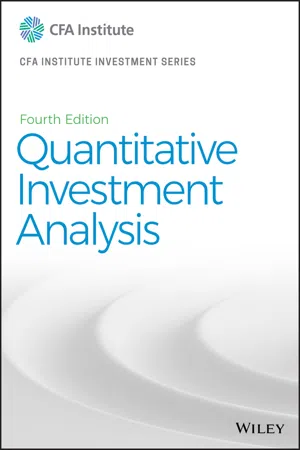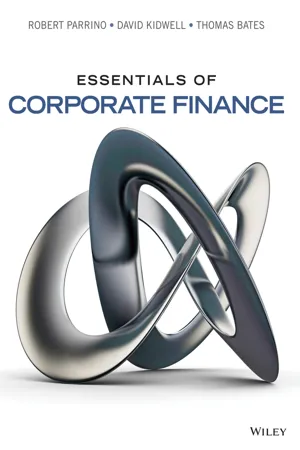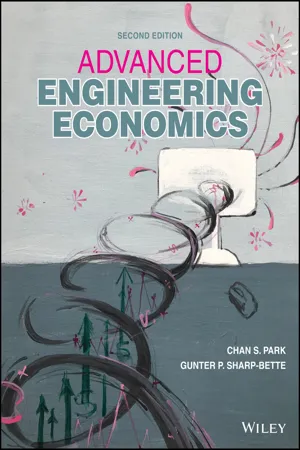Business
Present Value of Perpetuity
The present value of perpetuity is a financial concept used to calculate the current worth of a series of equal cash flows that continue indefinitely. It is calculated by dividing the cash flow by the discount rate, representing the opportunity cost of capital. This concept is important in business for evaluating long-term investments and determining the value of assets with perpetual cash flows.
Written by Perlego with AI-assistance
Related key terms
1 of 5
11 Key excerpts on "Present Value of Perpetuity"
- eBook - PDF
- Robert Parrino, David S. Kidwell, Thomas Bates, Stuart L. Gillan(Authors)
- 2021(Publication Date)
- Wiley(Publisher)
We then multiply the ordinary annuity value times (1 + i). Section 6.2 discusses the calculation of the present value and future value of an ordinary annuity and an annuity due. 3 Explain what a perpetuity is and where we see them in business, and calculate the value of a perpetuity. A perpetuity is like an annuity except that the cash flows are per- petual—they never end. British Treasury Department bonds, called consols, were the first widely used securities of this kind. The most common example of a perpetuity today is preferred stock. The issuer of preferred stock promises to pay fixed-rate dividends forever. The cash flows from corporations can also look like perpetuities. To calculate the present value of a perpetuity, we simply divide the constant cash flow (CF) by the interest rate (i). 4 Discuss growing annuities and perpetuities, as well as their application in business, and calculate their values. Financial managers often need to value cash flow streams that increase at a constant rate over time. These cash flow streams are called grow- ing annuities or growing perpetuities. An example of a growing annuity is a 10-year lease with an annual adjustment for the expected rate of inflation over the life of the contract. If the cash flows continue to grow at a constant rate indefinitely, this cash flow stream is called a growing perpetuity. Since a C-corporation has an indefinite life, when the cash flows from such a corporation are growing at a constant rate, they can be thought of as a growing perpetuity. The calculation of the value of a cash flow stream that grows at a constant rate is discussed in Section 6.4. 5 Discuss why the effective annual interest rate (EAR) is the appropriate way to annualize interest rates, and calculate the EAR. The EAR is the annual interest rate that takes compounding into account. Thus, the EAR is the true cost of borrowing or lending money. - eBook - PDF
- Robert Parrino, David S. Kidwell, Thomas Bates(Authors)
- 2016(Publication Date)
- Wiley(Publisher)
perpetuity A series of level cash flows that continue forever. ordinary annuity An annuity in which payments are made at the ends of the periods. WEB Visit the following webform that provides an online annuity calculator http://www.feike.biz/annuity.php Present Value of an Annuity We frequently need to find the present value of an annuity (PVA) . Suppose, for example, that a financial contract pays €2 000 at the end of each year for three years and the appropriate discount rate is 8 per cent. The time line for the situation is: 3 Year 2 1 0 8% € 2 000 € 2 000 € 2 000 PV = ? What is the most we should pay for this annuity? Of course, we have worked problems like this one before. All we need to do is calculate the present value of each individual cash flow present value of an annuity (PVA) The present value of the cash flows from an annuity, discounted at the appropriate discount rate. 6.2 Level Cash Flows: Annuities and Perpetuities 187 (CF ) n and add them up. Using Equation 5.4, we find that the present value of the three-year annuity (PVA ) 3 at 8 per cent interest is: = × + ⎡ ⎣ ⎢ ⎤ ⎦ ⎥ + × + ⎡ ⎣ ⎢ ⎤ ⎦ ⎥ + × + ⎡ ⎣ ⎢ ⎤ ⎦ ⎥ = × ⎡ ⎣ ⎢ ⎤ ⎦ ⎥ + × ⎡ ⎣ ⎢ ⎤ ⎦ ⎥ + × ⎡ ⎣ ⎢ ⎤ ⎦ ⎥ = + + = i i i P VA CF 1 1 CF 1 (1 ) CF 1 (1 ) €2 000 1 1.08 €2 000 1 (1.08) €2 000 1 (1.08) €1 851.85 €1 714.68 €1 587.66 €5 514.19 3 1 2 2 3 3 2 3 This approach to computing the present value of an annuity works as long as the number of cash flows is relatively small. In many situations that involve annuities, however, the number of cash flows is large, and doing the calculations by hand would be tedious. For example, a typical 30-year home mortgage has × 360 (12 months 30 years) monthly payments. Fortunately, our problem can be simplified because the cash flows (CF) for an annuity are all the same = = = (CF CF . . . CF CF) n 1 2 . - eBook - PDF
- Peter Moles, Robert Parrino, David S. Kidwell(Authors)
- 2014(Publication Date)
- Wiley(Publisher)
5 When that is done, the value of the term approaches 0, and thus: PVA 1 ¼ CF i 1 1 1 þ i ð Þ 1 ¼ CF i 1 0 ½ ¼ CF i ð6:4Þ CHAPTER 6 DISCOUNTED CASH FLOWS AND VALUATION 219 As you can see, the present value of a perpetuity is the promised constant cash payment (CF) divided by the interest rate (i). A nice feature of the final equation is that it is algebraically very simple to work with, since it allows us to solve for i directly rather than by trial and error, as is required with Equations (6.1) and (6.3). For example, suppose you had a great experi- ence during university at the business school and decided to endow a chair in finance. Endowed chairs provide salary and research support for top faculty. 6 The goal of the chair is to provide the chair holder with D 100 000 of additional financial support per year forever. If the rate of interest is 8%, how much money will you have to give the university foundation to provide the desired level of support? Using Equation (6.4), we find that the present value of the perpetuity is: PVA 1 ¼ CF i ¼ D 100 000 0:08 ¼ D 1 250 000 Thus, a gift of D 1.25 million will provide a con- stant annual payment of D 100 000 to the chair holder forever. There are two subtleties here that you should note. First, as mentioned earlier, the present value formula assumes that cash flows are paid at the end of the year. If our worthy chair holder needs to be paid when the chair is awarded, the donor would have to provide the university with an additional D 100 000. Thus, the total gift would be D 1.35 million. Note that the D 100 000 is already in present value terms, so it can be added to the D 1.25 million, which has been converted into present value terms. Second, in our problem, no adjustment was made for inflation. If the economy is expected to experience inflation, which is gener- ally the case, the chair holder’s purchasing power will decline each year. - eBook - ePub
- (Author)
- 2020(Publication Date)
- Wiley(Publisher)
6. THE PRESENT VALUE OF A SERIES OF CASH FLOWS
Many applications in investment management involve assets that offer a series of cash flows over time. The cash flows may be highly uneven, relatively even, or equal. They may occur over relatively short periods of time, longer periods of time, or even stretch on indefinitely. In this section, we discuss how to find the present value of a series of cash flows.6.1. The Present Value of a Series of Equal Cash Flows
We begin with an ordinary annuity. Recall that an ordinary annuity has equal annuity payments, with the first payment starting one period into the future. In total, the annuity makes N payments, with the first payment at t = 1 and the last at t = N. We can express the present value of an ordinary annuity as the sum of the present values of each individual annuity payment, as follows:where- A = the annuity amount
- r = the interest rate per period corresponding to the frequency of annuity payments (for example, annual, quarterly, or monthly)
- N = the number of annuity payments
Because the annuity payment (A) is a constant in this equation, it can be factored out as a common term. Thus the sum of the interest factors has a shortcut expression:In much the same way that we computed the future value of an ordinary annuity, we find the present value by multiplying the annuity amount by a present value annuity factor (the term in brackets in Equation 11 ).EXAMPLE 11
The Present Value of an Ordinary AnnuitySuppose you are considering purchasing a financial asset that promises to pay €1,000 per year for five years, with the first payment one year from now. The required rate of return is 12 percent per year. How much should you pay for this asset? - eBook - PDF
- Robert Parrino, David S. Kidwell, Thomas Bates(Authors)
- 2013(Publication Date)
- Wiley(Publisher)
126 The Time Value of Money, Discounted Cash Flows, and Valuation 5 1 Explain what the time value of money is and why it is so important in the field of finance. Explain the concept of future value, including the meaning of the terms principal, simple interest, and compound interest, and use the future value formula to make business decisions. Explain the concept of present value and how it relates to future value, and use the present value formula to make business decisions. Explain why cash flows occurring at different times must be adjusted to reflect their value as of a common date before they can be compared, and compute the present value and future value for multiple cash flows. Explain the difference between an ordinary annuity and an annuity due, and calculate the present value and the future value of an ordinary annuity and an annuity due. Explain what a perpetuity is and where we see them in business, and calculate the value of a perpetuity. Discuss growing annuities and perpetuities, as well as their application in business, and calculate their values. Discuss why the effective annual interest rate (EAR) is the appropriate way to annualize interest rates, and calculate the EAR. - eBook - ePub
- Robert Irons(Author)
- 2019(Publication Date)
- Routledge(Publisher)
When compounding an annuity to calculate a future value, the annuity due is compounded for one more period than the ordinary annuity, since the payments are made at the beginning of the period. This makes the future value of the annuity due equal to the value of the ordinary annuity multiplied by one plus the periodic rate.When discounting an annuity to calculate a present value, the annuity due is discounted for one less period than the ordinary annuity, since the payments are made at the beginning of the period. This makes the present value of the annuity due equal to the value of the ordinary annuity multiplied by one plus the periodic rate.This means that the value of an annuity due is equal to the value of the ordinary annuity multiplied by one plus the periodic rate, regardless of whether you are calculating a future value or a present value. This understanding makes calculating the PV or FV of an annuity due a simple step beyond calculating the value of the ordinary annuity.Perpetuities
A perpetuity is simply an annuity that has no scheduled end date. An example would be a preferred stock’s dividend; it is fixed in amount and paid on a scheduled basis with no end in sight. Since it has no end, a perpetuity has no simple formula for calculating its future value. However, the formula for calculating its present value is simple:PV=p e r p e t u i t yP M Ti- where: PMT is the annual perpetuity payment; and
- i is the annual discount rate.
Example. Suppose you had the opportunity to purchase a preferred stock that pays a $50 dividend each year. If your required return on this preferred stock is 8.50%, how much should you be willing to pay for this stock?Solution. 50 ÷ .085 = 588.24. You should be willing to pay up to $588.24 for this preferred stock.Amortized Loans
An amortized loan is a debt for which payments are calculated to be of equal value over the life of the loan, and which contribute to both the interest owed on the loan as well as the repayment of the principal. Early in the life of the loan, the principal owed is at its highest, and therefore the earlier payments contribute more to interest than to the repayment of the principal. Over time, the principal is reduced more and more, and so later in the life of the loan, the payments contribute more to repayment of the principal than to interest (i.e., as more principal is repaid, less interest is owed). Therefore, the makeup of the payments is mostly interest at first, but over time becomes less interest and more repayment of principal. So, while the amount of the payments does not change over time, the makeup of the payments (interest vs. principal) changes with each payment made. - eBook - ePub
- Michael Dempsey(Author)
- 2017(Publication Date)
- WSPC (EUROPE)(Publisher)
1 , is the first cash flow, which occurs at the end of the first period. On rearranging, the above providesIllustrative Example 3.2: Present value of a growing cash stream
A cash stream provides for a payment of $100 at the end of one year and payment at the end of each year thereafter growing at 8% per annum. The prevailing interest rate is 10%. Determine (i) the value of the future cash flows in today’s money.As a variation on the above, suppose that the cash stream offers $100 immediately with payment at the end of each year thereafter growing at 8% per annum (so that the payment at the end of the first year = $100 × 1.08 = $108).Determine (ii) the value of the cash flows in today’s money.(i)with Eq. (3.6), we have (ii)We now have3.3.2A perpetuity
An even further simplification of Eq. (3.3) is obtained when the growth rate is zero and we have $X1 at the end of each period “in perpetuity”. The PV of such a perpetuity is then derived from Eq. (3.6) with g = 0 asEquation (3.7) is actually quite “obvious”. To see this, consider that you deposit $100 (= PV0 ) with an annual interest rate (int) of 8% fixed indefinitely. In this case, you will be able to withdraw 8% of $100 = $100 × = $100 × 0.08 = $8 at the end of the first year and at the end of each year thereafter. Which is to say, your deposit of $100 provides you with $8 at the end of each year in perpetuity. Or, more generally, your deposit of PV0 provides you withwhere i = , at the end of each year in perpetuity. Rearranging the above relation provides: PV0 = , which is Eq. (3.7).3.3.3Present value of an annuity
We sometimes find it useful to consider an “annuity”, which is a security that pays a fixed amount, say, $X1 , at the end of each period for a limited number of periods, say, N - Ivan E Brick(Author)
- 2017(Publication Date)
- WSPC(Publisher)
Recall our discussion on page 27. In the real world no one asks, “WHAT IS THE PRESENT VALUE OF A PARTICULAR CASH FLOW?” The real world uses terms as “what is the price” or “what is it worth”. For example, assume that the interest rate (Wall Street usually calls the interest rate as the yield) is 10%. A security, a zerocoupon bond called a STRIP, offers to pay $500 at the end of year 10. No interim payment will be made before year 10. What should be the price for such a security? We already know that answer, it is worth $192.77.(b) Consider now another example. Assume that you receive $250 in year 1 and another $400 in year 2. Again, assume that the interest rate is 10%. What are these cash flows worth today? The present value equation is given byPV = $250/(1.1) + 400/(1 + 0.10)2 = $557.85.To do this problem, using a financial calculator, you must calculate the present value of each cash flow separately. (HINT: ACTUALLY, THERE IS AN EASIER METHOD TO DO THIS BUT YOU MUST CONSULT YOUR MANUAL. WE ARE SIMPLY TRYING TO CONCENTRATE ON LEARNING THE CONCEPTS.) In other words:The first cash flow of $250 at time 1 is worth $227.27. The second cash flow is worth $330.58. The sum of the two cash flows equals $557.85.The Present Value of An Annuity
An annuity is a cash flow received at the end of each year for a specified number of years. Your car or mortgage payment is probably structured as an annuity. To find the present value of receiving $100 per year for the next 15 years, we use the following formula:where n is the number of periods in an annuity and R is the interest rate. is the Greek letter sigma, which represents addition from period 1 to n in mathematics. The letter t is a time index. Hence, the above equation is telling us to do the following mathematical operations:100/(1 + R) + 100/(1 + R)2 + 100/(1 + R)3 + 100/(1 + R)4 + ··· + 100/(1 + R)n .Fortunately, we can use the PV(rate, nper, pmt, fv, type) function of Excel to evaluate annuities. Let us illustrate this with a few concrete examples:- eBook - PDF
- R. Charles Moyer, James McGuigan, Ramesh Rao, , R. Charles Moyer, James McGuigan, Ramesh Rao(Authors)
- 2017(Publication Date)
- Cengage Learning EMEA(Publisher)
3. Present value calculations determine the value today (present value) of some amount to be received in the future. 4. An annuity is a series of equal periodic payments. a. Ordinary annuity payments are made at the end of each period. b. Annuity due payments are made at the beginning of each period. 5. The future value of an annuity calculation determines the future value of an annuity stream of payments. 6. The present value of an annuity calculation determines the present value of an annuity stream of payments. 7. The net present value rule is the primary decision-making rule used throughout the practice of financial management. a. The net present value of an investment is equal to the present value of the future cash flows minus the initial outlay. b. The net present value of an investment made by a firm represents the contribution of that investment to the value of the firm and, accordingly, to the wealth of shareholders. 8. Other important topics include: a. Compounding frequency b. Determining the present value of perpetuities c. Determining the present value of uneven cash flow streams d. Determining the present value of deferred annuities 144 Copyright 2018 Cengage Learning. All Rights Reserved. May not be copied, scanned, or duplicated, in whole or in part. WCN 02-300 FINANCIAL CHALLENGE Pension Obligations and the Discount Rate Most larger companies, as well as federal, state, and local governments and not-for-profit organiza- tions, offer their employees pension benefits. Two basic types of plans are offered—defined contri- bution plans, for example 401(k)s, and defined benefit plans. With a defined contribution plan, through contributions from the employer and/or employee, the plan is fully funded on the day the employee retires, and the employer has no further financial liability to the pension plan. - eBook - PDF
- Scott Besley, Eugene Brigham, Scott Besley(Authors)
- 2021(Publication Date)
- Cengage Learning EMEA(Publisher)
All Rights Reserved. May not be copied, scanned, or duplicated, in whole or in part. Due to electronic rights, some third party content may be suppressed from the eBook and/or eChapter(s). Editorial review has deemed that any suppressed content does not materially affect the overall learning experience. Cengage Learning reserves the right to remove additional content at any time if subsequent rights restrictions require it. The adjustment made to Equation 4.6 to generate Equation 4.7 is shown in italics and highlighted in red. Applying Equation 4.7 to our example, we find PVAsDUEd 3 5 400 53 1 2 1 s1.05d 3 0.05 4 3 s1.05d 6 400(2.859410) 5 1,143.76 PVA(DUE) n —Financial Calculator Solution. As de- scribed earlier, to deal with annuities due, you must switch your calculator to the BGN mode. The inputs and the result for the current situation are N PV PMT FV 3 5 400 0 I/Y 5 21,143.76 Output: Inputs: ? BGN 4-3d Perpetuities Although most annuities call for payments to be made over some limited period of time, some annuities go on indefinitely, or perpetually. These perpetual annuities are called perpetuities. The present value of a perpetu- ity, which we designate PVP, is found by applying Equa- tion 4.8, which is simply Equation 4.6 when n 5 ∞: Suppose an investment promises to pay $100 per year in perpetuity. What is this investment worth if the opportunity cost rate is 5 percent? The answer is $2,000: PVP 5 100 0.05 5 2,000 This result shows you must invest $2,000 at a 5 percent annual interest rate if you want to pay yourself $100 each year; that is, $100 5 $2,000(0.05). Suppose the inter- est rate increases to 10 percent. What would happen to the investment’s value? The value would drop to $1,000: PVP 5 100 0.10 5 1,000 We see that the value of a perpetuity changes dra- matically when interest rates change. - eBook - PDF
- Chan S. Park, Gunter P. Sharp(Authors)
- 2021(Publication Date)
- Wiley(Publisher)
a. Find the present value of this cash flow stream over 10 years if money is worth 12% compounded continuously. b. The profit per year is expected to increase continuously because of increased productivity and can be expressed as f (t) = 250,000(2.0 − e −0.2t ) where t is time in years. Find the present value of this cash flow stream. c. Productivity increases as in part b, but competition reduces the profit continuously by 8% per year. Find the present value of the cash flow. 3.10. Consider the following simple inventory system. A stock of Q units is produced at a rate of a p units per day for a period T p . It is then necessary to leave the batch in stock for a period of T d , during which sorting, inspection, and painting are carried out. A quantity Q 1 is then supplied to the assembly line at the rate of a units per day for a period T c . The supply to the assembly is intermittent, so that after a supply period T c there is an interval T 0 before supply is resumed for another period T c , and so on. Assuming that the relationship between Q and a is defined as Q = ka, k is an integer, and h stands for a holding cost of one unit per unit time, answer the following questions: a. Draw the level of inventory position as a function of time t. b. Assuming continuous compounding at a nominal rate of r, find the expression of present value of the total inventory cost over one complete cycle. (One cycle is defined as a time interval in which the entire stock Q is depleted.) c. With Q = 1,000 units, a p = 10 units/day, T p = 100 days, T d = 50 days, a = 5 units/day, T c = 80 days, T 0 = 55 days, h = $5 per unit per year, and r = 12% compounded continuously, find the total present value using the formula developed in part b. 3.11. Consider an inventory system in which an order is placed every T units of time. It is desired to deter- mine the optimal value of Q by maximizing the average annual profit.
Index pages curate the most relevant extracts from our library of academic textbooks. They’ve been created using an in-house natural language model (NLM), each adding context and meaning to key research topics.










